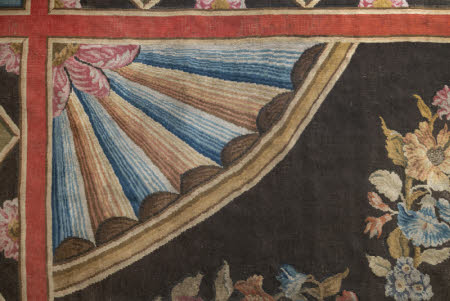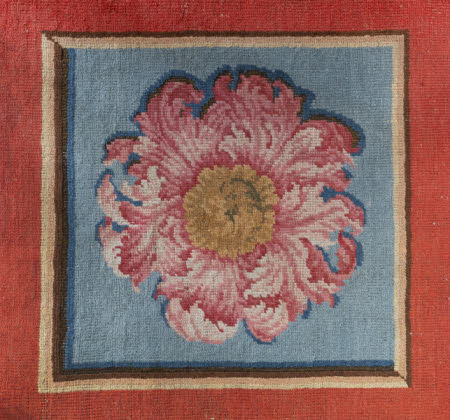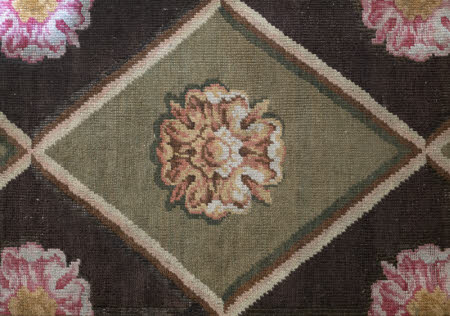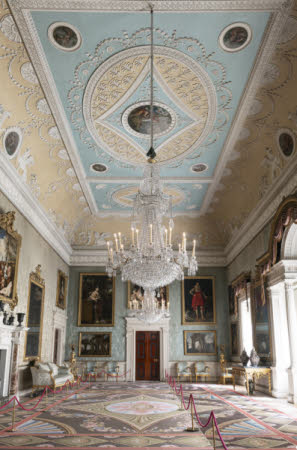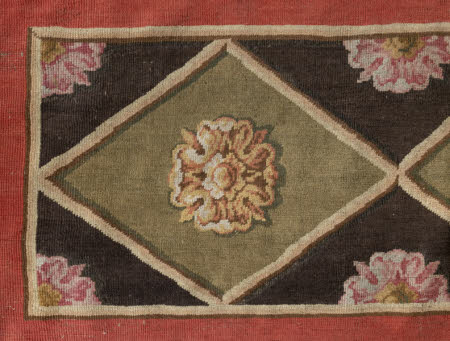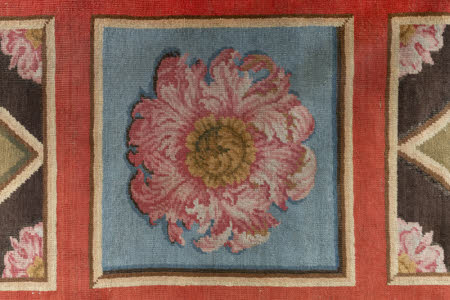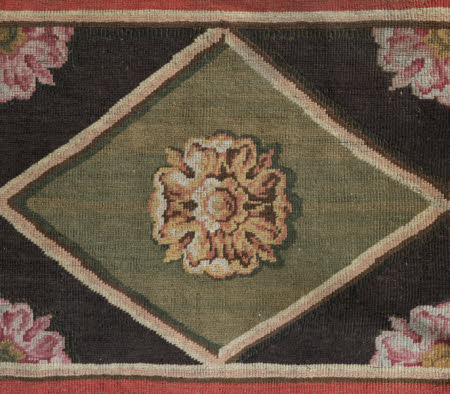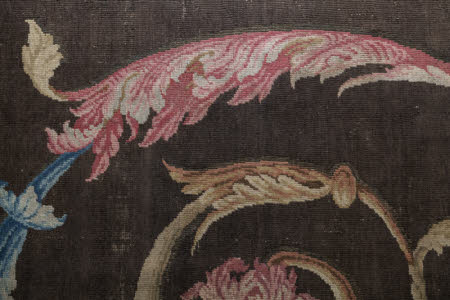Carpet
Thomas Whitty (1713 - 1792)
Category
Carpets, rugs and mats
Date
1770
Materials
Wool knots on wool warp and bast fibre weft
Measurements
6070 x 13300 mm
Place of origin
England
Order this imageCollection
Saltram, Devon
NT 872446
Caption
Carpets appear to be a particularly British obsession. Many small-scale, high-quality carpets were imported for use on tables in the 16th and 17th centuries, while rush matting was used on floors. Woven wool started to appear on the floors of wealthy homes in the early 1700s, providing greatly improved comfort, warmth, colour and a sense of luxury. By the 1750s, carpet factories were set up by weavers around London and in Axminster, Devon. One of the most significant and important carpets owned by the National Trust is this fine Axminster, which was commissioned for the Great Room (now known as the Saloon) at Saltram in Devon by John Parker (1734–88) and his wife Theresa (1745–75), and installed in 1770. It was designed by the celebrated architect Robert Adam (1728–92) to reflect the plasterwork celling, creating an elegant and harmonious effect. The carpet remains in place, and the room is one of the finest and most complete Robert Adam interiors.
Summary
A very large neo-classical carpet designed by Robert Adam to echo the pattern of the ceiling at the Saloon at Saltram, but using stronger colours to complement the pictures. It was woven at the Axminster carpet manufactory by Thomas Whitty (1713–1792), who was paid cash £126 directly by John Parker II (1735-1780), made 1st Baron Boringdon in 1784, in October 1770. Robert Adam’s drawing is held at the Sir John Soane’s Museum, dated 1768 and inscribed ‘Design of a Carpet for the Drawing Room at Saltram. The Seat of John Parker Esq.’ From 1755 onwards, Thomas Whitty sought to emulate the quality of large Turkish carpets, rather like the Savonnerie manufactory did in Paris. His Axminster carpet manufactory dominated the English market until the firm was declared bankrupt in 1835. Other prominent examples of large Axminster carpets can be found at Warwick Castle, Chatsworth and the British Royal Collection. Robert Adam also collaborated with the Moorfields carpet manufactory, which supplied a carpet for the Red Drawing Room at Syon House in 1762-4 and for the Drawing Room (c.1768-73), Tapestry Room (1775), and State Bedroom (1778) at Osterley Park (National Trust).
Full description
The carpet was commissioned by John (1734-88) and Theresa Parker (1745-75) from Robert Adam (1728-92) as part of a scheme of fashionable improvements at Saltram. Liaising with Adam through the design process, they variously accepted or rejected his designs for the interiors of the ‘Great Room’ (now the Saloon) and ‘Library’ (now the Dining Room.) that included proposals for ceilings, chimney pieces and friezes as well as decorative furnishings such a carpets, mirrors, pier tables and an urn. Robert Adam produced two signed and dated drawings of the carpet, a rough preliminary sketch ‘Carpet for Mr Parkers Drawing Room / Carpet / Mr Fermors Eating Room’ (Soane Museum Adam volume 8/99) and a coloured record drawing of a portion of the carpet, ‘Design of a Carpet for the Drawing Room at Saltram The Seat of John Parker Esqr, 1769’ (SM Adam volume 17/178). The large, rectangular carpet was designed to fill Saltram’s ‘Great Room’ and echo the plasterwork ceiling as part of the wider Adam-designed interior. In 1769 the carpet had been commissioned from Axminster and in August of that year, Frederick Robinson (1746-1792), Theresa Parker’s brother, writes of his visit to the factory to inspect the setting up of the loom. By 1770, the carpet was complete and delivered to Saltram; Frederick records this event too, remarking that “the carpet arrived this morning and was spread on the lawn – very beautiful indeed*.” John Parker’s account book shows a payment made to Whitty in October of that year for £126. Saltram’s carpet is amongst the largest ever made at the Axminster factory by Thomas Whitty (1713–1792), the factory’s founder, who specialised in making bespoke, hand knotted carpets on vertical looms. *Robertson, Frederick. Letter to Lord Grantham. Bedfordshire Record Office. L.30/14/333/63. 28th September 1770.
Provenance
Supplied by Thomas Whitty of the Axminster Carpet Manufactory to John Parker, (later made 1st Baron Boringdon) in 1770 and thence by descent. At Saltram by 1951 and accepted by HM Treasury in lieu of full payment of Estate Duty from the Executors of Edmund Robert Parker (1877-1951), 4th Earl of Morley and transferred on loan to NT Saltram in 1957 and transferred as an outright gift to NT in 1984 under s.9 of the Heritage Act 1980 to be maintained and preserved for display to the public at Saltram House with which they have a significant association.
Makers and roles
Thomas Whitty (1713 - 1792), maker Robert Adam (Kirkcaldy 1728 - London 1792), designer
